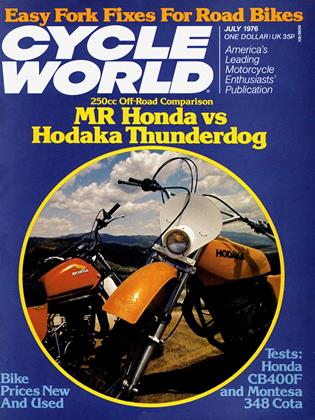Whose broad stripes and bright stars?
Carl Dills’. He’s America’s least prolific motorcycle maker.
Virginia DeMoss
IN SPITE OF Bicentennial minutes, beer cans and grocery bags, it looked as though the Harley-Davidson “Liberty Editions" would be the only concessions motorcycling would make to America’s big birthday. Afterall, Harleys and the red, white
and blue Rokons are the only bikes left that begin life in the United States. Unless, of course, you count the ones manufactured by Carl Dills. Carl makes American motorcycles, even though you won't find him listed in Wards Automotive Report and will find that his production numbers aren’t quite up there on the level of Harley’s. Fact
is, he averages about one bike a year. . .and this year it was the Bicentennial beauty pictured on these pages. Although Carl’s bikes are only about nine inches long, they probably contain more man-hours of work—at least 100 each—than any other bikes made anywhere.
Let’s see, for one bike a year, there’s the cost of those 100+ hours of labor (some of them at timeand-a-half, since they take place in the wee hours), materials, overhead, advertising and. . . . Wait a minute, that thing would have to cost a fortune; who could afford to buy one? Probably no one. But that fact hasn’t stopped production at the Carl Dills factory. Because he doesn’t sell his bikes, he gives them away. Like five motorcycles before
it, the Bicentennial Bike was donated to the Saddleback Motorcycle Corps as the Sweepstakes prize in its annual Easter run. Before that, Carl gave them away to cycle-riding friends.
The whole thing got started when he was made the recipient of a box of broken jewelry that someone had been using to make ornamental Christmas trees. When he sat down to begin production, he was at a loss for a subject. . .until a friend rode up on his full-dress Harley and served as inspiration. Other ideas have surfaced since
then, and besides motorcycles Carl has also created a jewel-encrusted model of the Spirit of St. Louis, a coronation coach and a Viking ship. Projects for the future will probably include a Roman chariot and a San Francisco style trolley car.
If Carl’s subjects are diverse, so are his materials. Besides jewelry, he’s executed bikes in shells, drafting supplies (such as pen points and compasses), and nuts and bolts. He once constructed one entirely from broken bits of diamonds, rubies and other precious stones given to him by a jeweler because they were worthless for jewelry making.
Whereas the construction cost of one of Carl’s models used to run around $50 because he could often find or was given many of the materials he needed, the cost has escalated to nearly $350. He attributes the rise to dramatic increases in the cost of costume jewelry—even in dime stores and thrift shops—and to the fact that his models have become more sophisticated and he more selective. He spent hours combing stores for the piece that became the fairing on the Bicentennial Bike. . .and then paid $22 for it.
The models are not constructed around any sort of base or framework, but are simply pieced together bit by bit. Construction begins with the wheels. . .in this case stacked Bicentennial coins that have been electro gold-plated and placed in a pendant designed to hold a silver dollar. Tires are of aquarium tubing. And a South American butterfly gave up a wing for the headlight. Just about all other pieces are refugees from America’s jewel boxes. . .18 ounces of rings, earrings, brooches, watches and necklaces. And for this year’s patriotic motif Carl had to replace 1500 stones, one by one, with red, white and blue ones. But he thinks it was worth the effort, the Saddleback Motorcycle Corps agrees, and so do we. What better way for Carl Dills, CYCLE WORLD and motorcycling to say: “Happy Birthday, America!”
end















